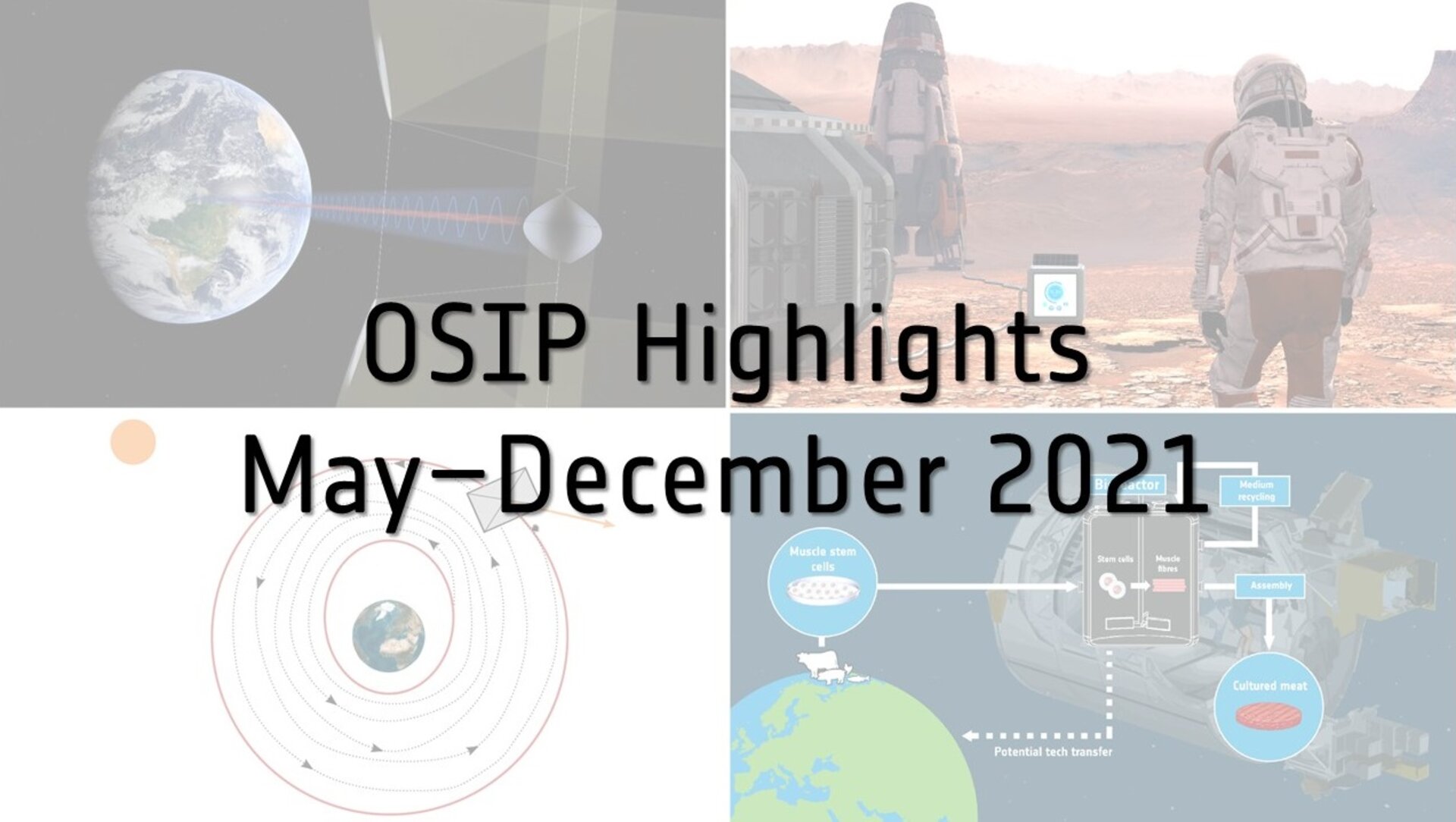Funding the future of European space through OSIP
What do astronaut sewage, solar power satellites, solar sails and cultured meat have in common? They can all be found among the topics of the 108 research and development activities funded by the Discovery element of ESA's Basic Activities between May and December 2021.
ESA set up the Open Space Innovation Platform (OSIP) to discover and invest in new unconventional ideas that could greatly benefit and advance European space industry and academia.
Here, the minds behind four of the projects funded between May and December 2021 tell us about their motivations and goals, as well as how ESA Discovery funding is helping them take their activity to the next level.
Turning astronaut sewage into fuel on Mars

For long-term missions to Mars, astronauts would need to figure out how to produce vital supplies like oxygen, water and fuel on site, as taking it with them would be far too expensive. A team from Spanish technological centre Tekniker is working on a system that uses sunlight to produce fuel from wastewater. The results could help tackle climate change on Earth.
Borja Pozo from Tekniker explains: "We aim to make the first reactor to produce space propellant on Mars using the planet's air, which is 95% carbon dioxide. The reactor will be powered by sunlight, and astronauts' greywater will be used to help in the production of the propellant. Bringing all these concepts and technologies together to create an efficient and operational system is a challenge, but thanks to this project Europe will have a unique system to provide other space agencies and companies, as well as reduce its dependence on technology from other space agencies."
Jean-Christophe Berton, ESA technical officer for the project, explains further: "The outcome of this activity could provide ESA with valuable input on the production of propellant on Mars or to power remote sites like ground stations on Earth. It could also potentially provide input on how to decarbonise our own atmosphere."
"For example, the technology might be used for carbon dioxide reduction solutions in industry or in any land-based sector," Borja adds. "In addition, the technology can be used to develop similar new products that reuse greywater produced by companies or personal means of transport such as boats and motorhomes."
An end-of-life strategy for solar power satellites

Solar power satellites could face the Sun 24/7 to capture lots of sunlight before beaming energy down to Earth, the Moon or other planets. They would be the largest human-made structures ever put into orbit.
As these satellites would most likely be built in orbit using robots, once they reach the end of their useful lives the reverse process could be used to reduce them to their individual parts. A team from Frazer-Nash Consultancy is exploring how these parts could be repurposed or reused for new applications, and how a recycling strategy could be incorporated into their initial design.
"In the space industry, decommissioning has traditionally meant leaving a satellite in orbit at the end of its life – this is leading to a growing problem with space debris," says Ben Turner from Frazer-Nash Consultancy. "Solar power satellites are still at a very early stage in their development life cycle, and this study presents an opportunity for sustainable approaches to decommissioning to be 'baked in' to the designs."
Ben continues: "The ESA Discovery funding means we can start to influence architecture and design choices at an early stage to ensure space-based solar power is developed sustainably and responsibly. This study may identify strategies that will benefit other spacecraft in the future, not just solar power satellites."
ESA technical officer for the project, Advenit Makaya adds: "This activity is addressing the important topic of space sustainability, which will grow in focus worldwide and is already mentioned in ESA Agenda 2025. As such, this activity sits nicely at the interface of the work that several ESA teams are doing, such as Clean Space on on-orbit servicing and space debris management, or the Space Resources Strategy which also looks at recycling capabilities."
Improving the control of solar sails

Like wind sails use wind to propel sailing boats through water, solar sails use sunlight to propel spacecraft through space. Solar-sail-propelled spacecraft can reach speeds that would be practically impossible for chemical rockets to achieve, and can be placed in orbits that would otherwise be unstable.
But just like wind sails, solar sails must be carefully controlled to send a satellite in the right direction. A team from the French National Institute for Research in Digital Science and Technology (Inria) is investigating how to improve the control of solar sails, in particular when leaving Earth or re-entering the atmosphere.
Alesia Herasimenka from Inria explains what the research involves: "First we analysed the controllability of a solar sail around a planet or an asteroid. We formulated a minimum optical requirement for controllability. This requirement does not depend on the gravitational pull of the body which the sail is orbiting, so it may be used when designing future missions that use solar sails. The second part of the research focuses on optimal control of solar sails."
"ESA's expertise on ambitious space missions is a perfect complement to the theoretical background of our team," continues Alesia. "The results may be used by companies designing low-thrust satellites and in particular solar sails. A direct application would be a deorbiting mission using solar sails, which is also one of the interests of ESA."
Samir Bennani, ESA technical officer for the project adds: "The relevance to ESA of this research on solar sails is the development and demonstration of advanced robust control techniques and algorithms. The novel method will deliver substantial performance improvements in that it will explore the achievable limits of system performance."
Feeding astronauts with cultured meat

Humans undertaking long stays away from Earth, for example trips to Mars, will need to find ways of producing food in their spacecraft or on site.
ESA engineer Paolo Corradi used OSIP to propose an idea to apply cellular agriculture to grow cultured meat in space. Two teams of scientists and engineers are now being funded by ESA Discovery to develop the concept further.
One team is composed of young German company yuri and Reutlingen University, and the other of UK companies Kayser Space, Cellular Agriculture and Campden BRI. In an example of how ESA Discovery is supporting companies not traditionally involved in the space sector, Cellular Agriculture is a startup working on cultured protein, whilst Campden BRI has over 100 years' experience in science and technology for the Earth-based food and drink industry.
"If we want to succeed in long-term human exploration missions far from Earth, we need to rethink our current approach to astronaut nutrition and provide the means to efficiently produce food on board, possibly integrated within the regenerative life support system of the spacecraft," explains ESA environment control and life support engineer, Christel Paille, who is working with Paolo on these activities.
Based on the outcome of this work, the teams will propose a plan for the development of a cultured meat system and assess the potential commercial interest for both space and ground applications.
"As an additional outcome, we hope that the research on production systems for cultivating meat in space could one day also contribute to advancing the technology used to produce cultured meat on Earth, which could phase out the existing unsustainable meat production." adds Paolo.
Discover more about ESA's Open Space Innovation Platform, including how you can submit your own ideas, via our dedicated webpage.















 Germany
Germany
 Austria
Austria
 Belgium
Belgium
 Denmark
Denmark
 Spain
Spain
 Estonia
Estonia
 Finland
Finland
 France
France
 Greece
Greece
 Hungary
Hungary
 Ireland
Ireland
 Italy
Italy
 Luxembourg
Luxembourg
 Norway
Norway
 The Netherlands
The Netherlands
 Poland
Poland
 Portugal
Portugal
 Czechia
Czechia
 Romania
Romania
 United Kingdom
United Kingdom
 Slovenia
Slovenia
 Sweden
Sweden
 Switzerland
Switzerland



























